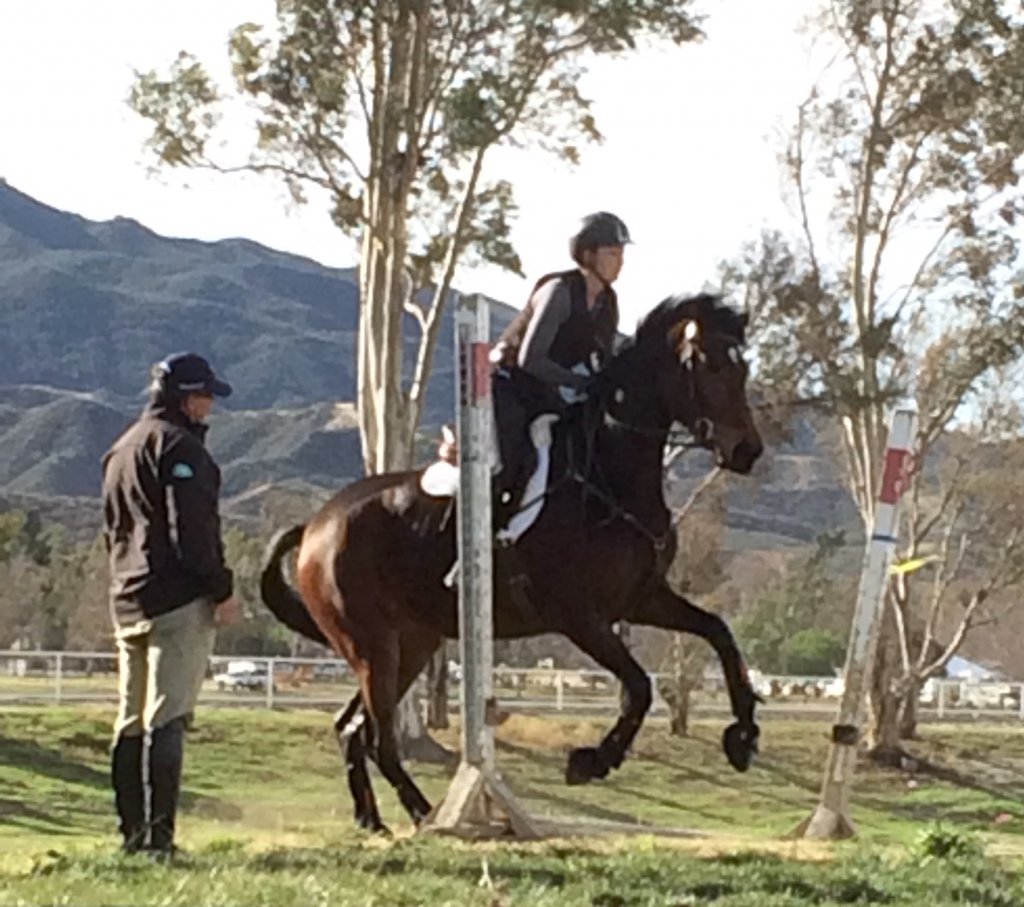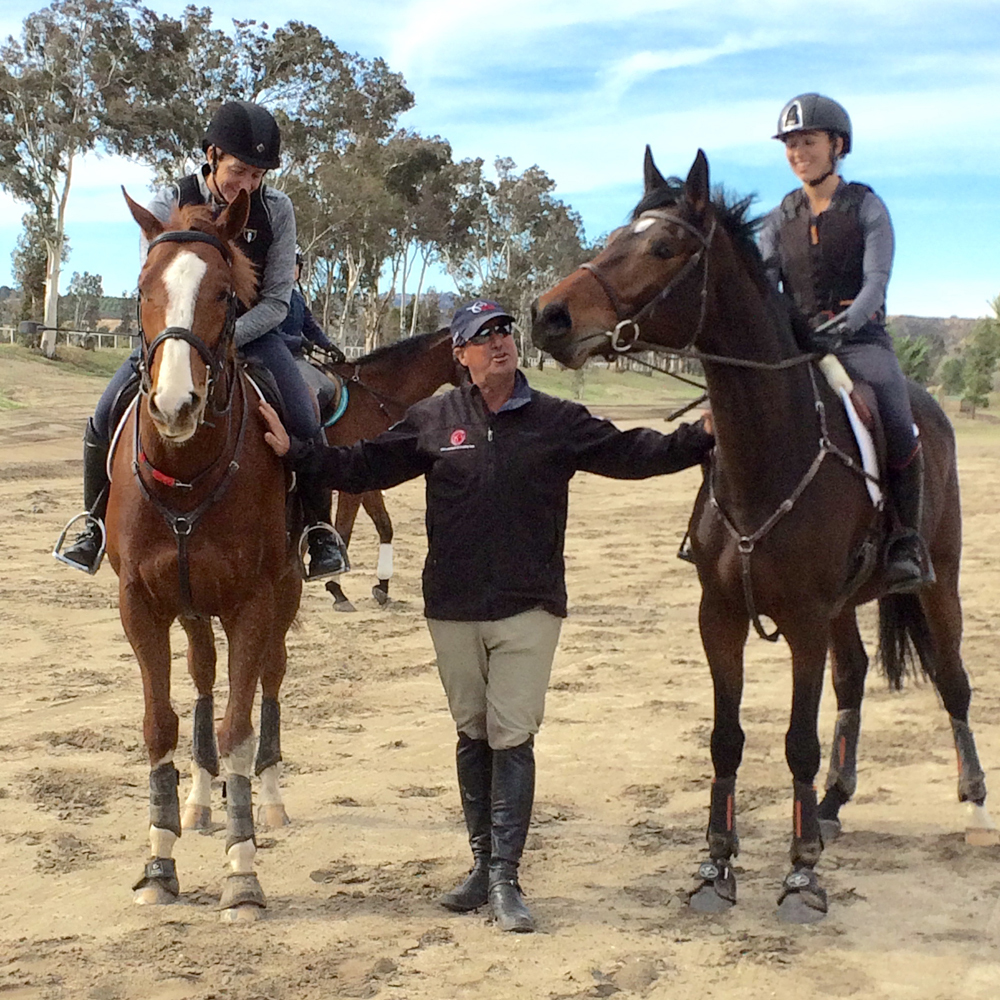The Progression of Horse and Rider with David O'Connor: Cross-Country

Each year the Instructor’s Certification Program (ICP) brings in phenomenal instructors to host two symposia, one on each coast of the country. This year’s symposia features U.S. Chef d’Equipe David O’Connor who took instructors through “The Progression of Horse and Rider.” Laura Powell recaps her experiences in a three-part series of the West Coast Symposium, hosted by Galway Downs. The USEA would like to thank Event Clinics for making our ICP Symposiums possible!
Part I: FlatworkThe theme of rider responsibilities of direction, speed, rhythm and balance was reiterated on the cross-country course. The lesson in the open should contain plenty of exercises that help set students up for the instinctive moment through a consistent process. The riders need to learn the systems described throughout so they learn to make their own decisions and react instinctively and appropriately.
The cross-country experience for young horses requires setting them up for successful situations in a “very structured playground” and to teach them to “go there”. O’Connor emphasized the importance of teaching confidence through a progression of exercises, beginning with the simplest ones, to give them time to see and process the information and then jump.
There are two stages described while on the cross-country course according to O’Connor: the gallop stage and the prep stage. In the gallop stage, the rider travels between fences in a galloping or two-point position. In the prep phase, the rider stretches up with his shoulders, has his legs on, sinks the hips back toward the back of the saddle five to six strides ahead of any jump. Riders must be careful establish a clear differentiation between their position in the gallop and prep phases so that they clearly communicate to their horse when a jump is coming.
O’Connor had riders bridge their reins again in order to help keep the hands together to keep the horse straight. Holding hands down and out wide was discouraged as this often makes the rider lose control of the horse’s shoulder. The hands should never be any wider apart than the horse’s shoulders.
Consistent with instruction in the show jumping arena, O’Connor asked riders to more accurately determine distance to the jumps. It is helpful to put a marker 6-7 strides out from jump to train the rider’s eye. This distance gives the horse time to look and react to the fence. The rider must have the elements of direction, speed, rhythm and balance established by this distance.

3-and 4-year-olds
The cross-country jumping exercise began with going up and down a mound to get the horses relaxed into a softer rein and to get the horses feet moving. This is also a good exercise to teach the riders they actually have better control when they let go. The reins should be held to create a corridor for the horses to travel within.
Gradually the exercise was progressed by a pole being added at the top of the mound, then a cross rail, and finally a vertical. The riders were constantly reminded to manage their direction and speed. Next O’Connor had riders take the young horses over single fences in and out of the water and over simple tables in the field. The horses were initially trotted to the fences and gradually progressed to cantering to and away from the fences.
Simple logs were used to teach the horses to trot the fences, then canter and eventually to gallop to the fence. Small tables are introduced and progressed the same way. If the horses rushed the fences, O’Connor had riders either ask these horses to make a turn or downward transition after the fence. If the horse hesitated swerves on the approach to a fence or gets “hung up” in the air, they were made to gallop away from the jump immediately upon landing. Repeating this exercise and reminding the riders of their responsibility of direction and speed improved this type of jumping considerably.
Once everyone seemed to have a solid foundation, O’Connor introduced additional cross-country elements. The group started with ditches. It is imperative that the horse has a positive experience when jumping ditches for the first time. As with anything potentially scary, have the horse walk both directions around the ditch starting with 10 feet away, then gradually shrink the circle closer. Setting two standards with a pole over the center of the ditch will ensure that the horse never thinks about stepping down into the ditch
When jumping banks, always start with a jump up the bank first. Riders should approach it like a vertical. When first going up a bank the rider must grab mane and get off the horse’s back. The rider’s eyes should be on the bank on approach while keeping the legs on. When going down a bank the horse needs to be allowed to look down. The rider must maintain a loose contact as if the horse is going down a steep hill. The looser contact encourages the horse to drop in close off of the bank, while a strong contact encourages the horse to jump further out off of the bank.
4-to 5-Year-Olds
After a similar warm up as in the first group, the horse and rider pairs in this group were required to do a line of fences that included a table, a log on a mound and a corner, first one individual jump, then two in succession and eventually all three jumps in a row.
One of the first techincal jumps O’Connor introduced to this group was a corner. When jumping a corner, O’Connor urged riders to never school a corner or a jump narrower than nine feet without flags to define the jump. If a horse has a runout, the instructor should put a guide rail off the corner of the jump at slant. After tackling that successfully, the rain can drop completely to the ground and finally be taken away.
If a horse stops at a fence, the rider should not hit the horse with the bat. O'Connor informed the audience that a crop means go forward and should not be used as a punishment. After a stop, the rider is instructed to rein the horse straight back far enough that he can then canter to the jump. If the rider takes the time to do this during a competition, the horses will not stop again.
While jumping tables, there is not much of a change in speed required from the galloping to the prep stage. As an exercise for this group, the horses galloped over one table several times and then jumped a table to a second table and finally jump 3 tables in succession. Each table was 10-12 strides apart. The riders practiced doing this line of tables repeatedly to work on timing and keeping still before and over the jump. This type of exercise teaches the rider to pay attention to direction and speed.
6- to 7-Year-Olds
With the final group of horses and riders, the exercises were again progressively more difficult. The rider responsibilities were reiterated and the riders were given plenty of opportunity to practice “instinct training” by doing exercises where they had to practice correct direction, speed, rhythm and balance in combinations repeatedly. They were given visual cues when needed, and O’Connor pointed out how he watched the riders’ eyes to monitor how quickly the riders were able to recognize and effectively correct a problem that came up in a line.
O’Connor asked this group to each define a problem they have had. Then, riders were asked to describe, in the simplest terms, how they were going to fix that problem. After discussion, riders practiced fixing their individual problems until their made an effective correction. O’Connor explained this was practicing drills for instincts.
Questions instructors can use to make sure riders understand:
1. What do you want to accomplish?
2. Where / when will you do that?
3. How you going to do it?
This group of riders spent time practicing combinations with precision and accuracy in direction and speed, emphasizing where the riders’ eyes were focused on the approach to each jump. A rider’s eye should be set on the approaching jump until the fence disappears between the horse’s ears, then should focus on the next jump.
When approaching more technical questions, as this group did, it remains paramount that riders have the ability to steer primarily with their legs. The reins should stay consistent like a set of railroad tracks to direct the horse, but should not be tugging in an effort to steer.
By this stage of training, the horse should have four speeds or “gears,” like driving a manual car. The gear you shift to depends on the face of the jump or what comes after a jump that a horse may need time to process. For a vertical face or a narrow fence, the horse should be taken down one gear. Also for a drop fence, jump into water, a turn after a fence, the horse should be taken down a gear. For terrain a horse should move forward up the hill and should collect going down a hill.


Thanks David! Wendy Wergeles Photo.
O’Connor brilliantly connected his themes throughout the three phases of this symposium. David provided an enormous amount of valuable information for all that were present. All of the horse and rider pairs came away from the sessions with marked improvement after the lessons. Thank you to David O’Connor for the excellent instruction and demonstrations! Thank you to the riders who all came so professionally prepared and worked so hard to meet David’s high standards! Many thanks to Wendy Wergeles and the other Area VI diehards for putting this excellent ICP Symposium together. And thank you to Robert Kellerhouse for all his efforts in securing Galway Downs as our venue.
About Event Clinics
Event Clinics Inc. was launched in May 2015 to enable Riders to easily find and register for clinics with the world’s top riders, as well as premier schooling opportunities. Use of Premier Registrar Service platform reduces a rider’s discovery, registration and payment effort from an hour or days to less than two minutes. Organizers have instant access to registration details, documents, & funds. The EC Instant Pay feature enables up to five custom recipients to receive payment for each registration. With unique proprietary software and a scalable database, the Event Clinics system is able to support thousands of rider registration transactions annually with associated document storage. To learn more about Event Clinics, visit: www.eventclinics.com














